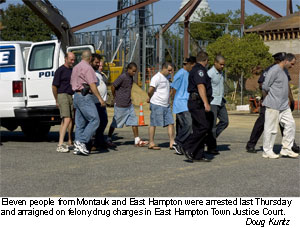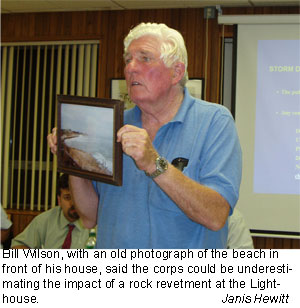Cops Round Up Eleven on Felony Cocaine Charges, Morning wakeup call; more arrests may follow
Cops Round Up Eleven on Felony Cocaine Charges, Morning wakeup call; more arrests may follow

Eight Montauk residents and three East Hampton residents were rounded up at dawn last Thursday after a six-month-long investigation into the "sale and distribution of cocaine in the East Hampton area," according to the East Hampton Town Police and the East End Drug Task Force.
Each of the 10 men and one woman led into court in handcuffs last Thursday afternoon was arraigned on narcotics-related felony charges before East Hampton Town Justice Catherine A. Cahill.
All but one, Alexander Costano, were charged with one count of felony conspiracy, which carries a minimum prison sentence of one year. Mr. Costano was charged with felony criminal possession of a controlled substance, which carries a minimum sentence of three years.
Mr. Costano, 28, and Juan E. Lopez-Garcia, 26, were held without bail at the Suffolk County jail in Riverside. Ambioris E. Fernandez, 28, Ruddy M. Padilla, 36, and Luis E. Aquino, 43, were unable to post bail and were still in jail yesterday. Justice Cahill had set their bails at $50,000, $100,000, and $200,000.
Shawn M. Hewitt, 36, and Christopher J. Hewitt, 40, were initially unable to post $2,500 bail and went to jail but were released on Monday after making bail. Loren R. Card, 50, Philip Marcotrigiano, 44, Bonnie J. Hegner, 35, and Kenneth E. Simonetti, 47, each posted $2,000 bail and were released from custody that day.
One person, whom police have not named, was also picked up last Thursday morning, questioned, and then released without charges.
Police said those charged were arrested at various locations last Thursday morning. Officers also executed search warrants at three houses in "the East Hampton area" last Thursday. East Hampton Town Police Detective Sgt. Chris Anderson would not say whether the searches resulted in some of the arrests last Thursday.
Trevor Darrell, an assistant district attorney who requested bails of over $10,000 for almost all of those arrested, asked that Mr. Costano and Mr. Lopez-Garcia, both of whom have lived in East Hampton for three years, be held without bail. In the courtroom he referred to Christopher and Shawn Hewitt as "members of a distribution ring," and said that Mr. Padilla was "moving" 250 grams of cocaine a week.
Bob Clifford, the spokesman at the Suffolk County district attorney's office, did not return calls for additional information by press time. He did, however, send an e-mail on Friday that said the investigation was continuing and that more arrests were expected.
"There are still unresolved issues and possible defendants in play in the narcotics investigation," he said. He said he expected "closure" on Monday, but did not return phone calls or e-mails made that day.
Mr. Card, Mr. Marcotrigiano, Ms. Hegner, and Shawn and Christopher Hewitt are longtime residents of Montauk, and Mr. Simonetti has been a bartender at Gurney's Inn in Montauk for three years.
Detective Anderson said police would not release additional information about the arrests, including addresses for the defendants, at this point. "Police are continuing their investigation and more arrests are expected," said a press release from the East Hampton Town police on Friday.
Mr. Fernandez said in court that he lives on Mulford Avenue in Montauk with his wife and child. Mr. Aquino said he has been living at the Neptune Motel on Euclid Avenue in Montauk for three months. Mr. Trevor said police had found $10,000 in cash and a one-way ticket to the Dominican Republic in Mr. Aquino's possession.
Mr. Costano and Mr. Lopez-Garcia have both lived in East Hampton for three years, they told Justice Cahill last Thursday. Mr. Padilla has been living in East Hampton for seven months.
Except for Mr. Simonetti, whose father came to court with a lawyer for him, the 10 other people arrested did not yet seem to have long-term legal representation as of last Thursday. Justice Cahill warned all those who would not be using a Legal Aid attorney to get a lawyer "sooner rather than later."
Shawn Hewitt, who lives on Tuthill Road in Montauk, has criminal charges pending in East Hampton Town Justice Court for allegedly leaving the scene of an accident with serious injury, a felony, on June 21 in Montauk.






